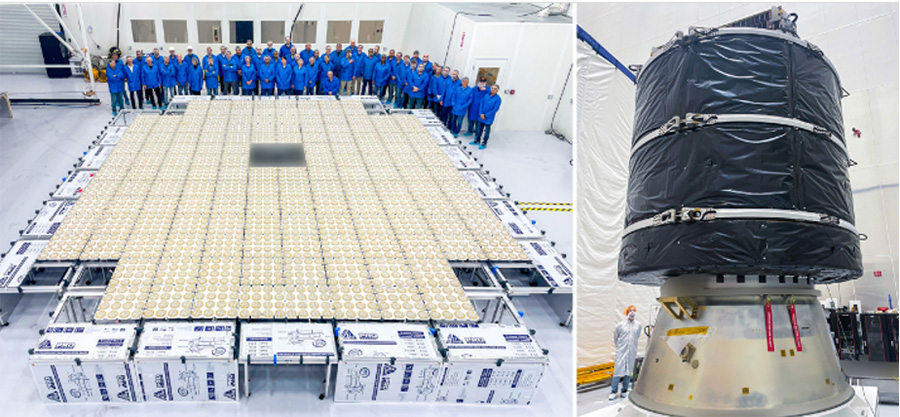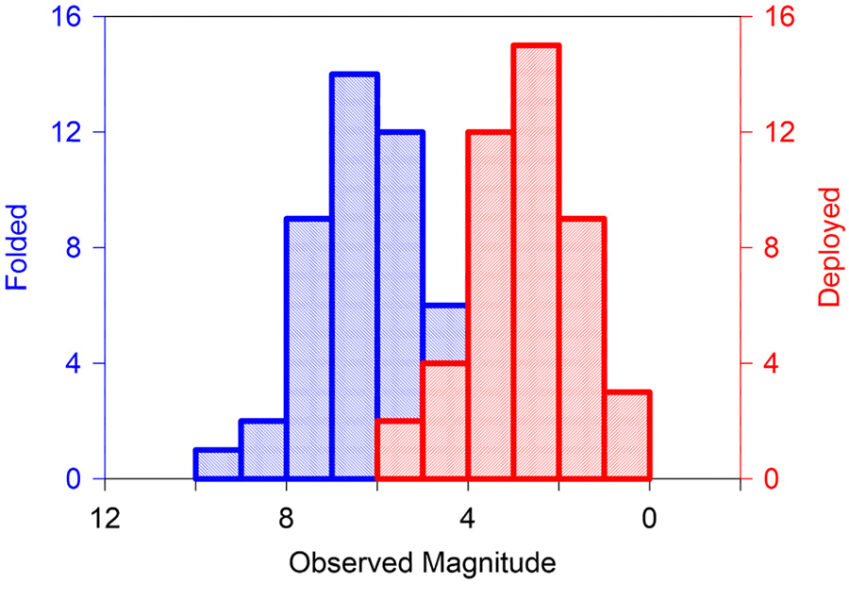The unfolding of the BlueWalker 3’s giant flat-panel antenna array resulted in a satellite 40 times as bright, outshining most stars.
The prototype of a new constellation of very bright Earth-orbiting satellites, named BlueWalker 3, was launched on September 11th, and as of a few days ago, it has brightened considerably. The AST SpaceMobile company behind the launch plans to orbit at least 100 more satellites like BlueWalker 3 by the end of 2024.
Amateur astronomers are concerned that the constellation of satellites will detract from the beauty of the starry skies; for professional astronomers, the satellites will interfere with scientific observations of faint objects. This new constellation would add to the numerous spacecraft already crowding the heavens.

AST SpaceMobile
The BlueWalker 3 spacecraft is so large it had to be folded up to fit in its rocket before launch. The satellite was designed to unfold itself after ground controllers had completed on-orbit testing. When fully deployed, its giant flat-panel antenna array spans 64 square meters (689 square feet).
In response to the concerns of sky watchers, Sky & Telescope invited readers to record the brightness of BlueWalker 3 before and after unfolding. Characterization of satellite brightness provides information for observers wanting to avoid the brightest spacecraft. Brightness measurements also provide feedback to engineers in order to make satellites fainter.
Visual magnitudes recorded by backyard observers and CCD magnitudes obtained at professional observatories have already been used to study the brightness of the thousands of Starlink satellites launched by SpaceX since 2019. Visual findings are directly applicable to the appearance of satellites in the sky as seen by amateur astronomers and others who view the heavens. CCD magnitudes are generally filtered to isolate brightness at specific wavelengths, so they apply more directly to the impact of satellites on astronomical research.
Observers began sending me reports just a few days after BlueWalker 3 was launched. In addition to the magnitudes recorded by Sky & Telescope readers, I also collected data from the SeeSat email archive and other public sources of satellite information. Early results indicated that the satellite in its folded-up configuration was relatively faint, with magnitudes generally between 4 and 8, depending on the distance to the satellite as well as its illumination by the Sun.
Then, on the morning of November 11th, Scott Harrington in Arkansas and Paul Maley in Arizona reported that the satellite had suddenly become much brighter. They recorded magnitudes 1.5 and 1.0, respectively, as BlueWalker 3 passed overhead. These observations indicate that the flat-panel array had been deployed, reflecting much more sunlight. Scott and Paul added more observations to the database every morning through November 14th. Richard Cole processed much of the data during that time.
Deployment resulted in about a 4-magnitude change; that is, the satellite became 40 times brighter in the sky. This study confirmed that this satellite and the constellation of similar satellites to follow will pose problems for amateur and professional astronomers. The follow-on satellites, called BlueBirds, are expected to be even larger than BW3, so they will likely be brighter, too, unless AST SpaceMobile changes their design.

 7
7
Comments
Anthony-Mallama
November 17, 2022 at 11:43 am
Ron Lee also contributed magnitude data for this study. I accidentally omitted his name in the figure caption.
You must be logged in to post a comment.
Lindsay
November 18, 2022 at 6:44 pm
It is high time there be an international treaty signed by the major countries that defines or requires an upper limit on number and size of launched objects by any one company or country per year. Furthermore, these entities must file their plans publicly 12 months before launch, giving time for interested parties to comment and object. Part of each plan should be how and when these launched objects would be intentionally destroyed to clean up the clutter after x many years of operation.
You must be logged in to post a comment.
Anthony-Mallama
November 19, 2022 at 7:28 am
Thank you for the comment, Lindsay. The International Astronomical Union is addressing that issue. There is information about their work here: https://cps.iau.org/. See the ‘policy hub’ link where interaction with the United Nations is described. People who feel strongly about this issue can join the IAU group and support their activities.
You must be logged in to post a comment.
LoveMyDarkNights
November 19, 2022 at 2:48 pm
This whole situation will quickly spiral OOC if not stopped at this point, just as soon as possible. The IAU is probably the best current point of leverage. To be at all effective, the solution to the eventual grotesque photo-damage of the Earth's night skies does have to be an international effort to set standards for both the dark sky and brightness of man-made objects, and authority to enforce them. Otherwise, we will quickly over-populate the night skies with unnecessarily bright orbiting objects of all descriptions. It is possible to make such objects fully functional without being brilliant or otherwise sky-damaging. But we currently lack any regulatory or enforcement authority-holding structure that can even consider the issue, much less control it. Instead of being blind-sighted (pun intended) by this stuff only after it gets launched, there needs to be a fully review and permitting process that both sets stringent standards for orbital brightness, and holds permitting authority to assure that the standards will be met.
It is important to identify the current active agency in this. Elon Musk, and his self-agrandizing ilk, who love to see their multi-thousands of objects above Earth in orbits to last hundreds to thousands of years, are only the primary perpetrators.
The real authorization point, and the only one right now, is the FCC. They held the Federal authority over Musk's StarLinks. Those satellites were authorized by the Trump era's FCC, and Musk timed his initial permitting and rollouts accordingly. The FCC holds no formal authority over issues of light pollution, nor do its members have essentially any expertise at all with the issues involved. And functionally, they simply cannot, statutorily, evaluate extra-terrestrial light pollution caused by commercial operators (few if any of whom who hold any concern for the photo-damaging aspects of their products). The current FCC simply holds no authority for such enforcement, nor even for any review.
So, those rushing into the vacuum of space with the emerging next generation of commercial vacuum-filling massive space-based communications have no concerns for light pollution caused by their products, and the Federal agency holding authorization responsibility does not hold any statutory authority even to consider light pollution, much less affect authorizations based on damage to world astronomy, nor even to consider truly destructive effects on the Earth's night skies.
It's all just an unregulated wild-west right now, with a satellite-rush just beginning.
I would like to think that the future can be "bright" on these vitally important issues. However, right now, with no US national authority over them, and certainly no world authority, unfortunately the future does look bright, but only in the worst of ways.
Still, it cannot hurt to make US Federal authorities, e.g., the FCC, and probably a few others, aware of the current and upcoming serious damage to a truly unique world-wide birthright of all people, the night skies. Raise the awareness levels that this is a genuine issue. And otherwise to vigorously support the IAU's efforts, engage the UN, etc. Ultimately, the solutions to this damage will have to be international.
You must be logged in to post a comment.
RKBerta
November 20, 2022 at 4:53 pm
It is hard for me to imagine who in their right mind would have allowed the huge numbers of commerical BRIGHT satellites that are quickly ruining the night sky view for professional and amateur astronomers. I have been an astrophotographer for 55 of my 75 years on earth. Few are the photos i take now that are free of intrusion by satellites. I remember when light polution was our biggest concern....now we have to worry about all those satellites.
Perhaps a lot of money has gone into the hands of decision makers....or the people of all countries don't care about preserving something as precious as our clear skies....but we have lost a LOT ;-(
When a top exec in this endeavor says that it is no big deal.....just put the telescopes in space. I for one am not happy that he is willing to scrap all those billions of TAX PAYER DOLLARS spent on those big earth based telescopes.
I am also worried about the danger to future missions. in the past the launch and re-entry were the dangerous part of a trip to space....now they have to dodge all that equipment in space.
I guess I will need to spend more time doing solar astrophotography instead of night time imaging ;-(
You must be logged in to post a comment.
Michal
November 22, 2022 at 9:17 am
This story did not help my mood at all:
Esa mulls Solaris plan to beam solar energy from space. https://www.bbc.com/news/science-environment-62982113
You must be logged in to post a comment.
Anthony-Mallama
November 22, 2022 at 10:27 am
Each satellite would be 1.7 km long. Yikes!
You must be logged in to post a comment.
You must be logged in to post a comment.